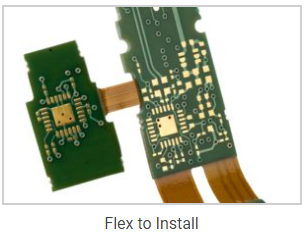What is a Rigid Flex PCBs?
A rigid flex printed circuit board (PCB) is a hybrid circuit board design that integrates elements from both hardboard and flexible circuits. Rigid flex PCBs are rigid at some points on the board and flexible at others. Because of this, rigid flex circuits can be folded or continuously flexed while maintaining the shape of areas that need extra support. The circuits are typically multi-layered and are comprised of flexible circuit substrates joined with rigid boards. The flexible layers are buried internally and completely penetrate the rigid sections of the PCB.
One of the key benefits of a rigid flex PCB is its slim profile. The standard dielectric in flexible circuits is .001 – .002”, making it a great choice for ultra thin—and ultra light—packaging needs. Adhesiveless laminates, HDI, and thin copper layers make it ideal for fine line technology, giving you the smallest, thinnest, and lightest solution for your circuit designs.
Rigid Flex Types
Rigid flex PCBs support two primary application types: flex to install and dynamic flex.
Flex to install is the most common type of rigid flex PCB application. In this circuit application, the board folds only once when the device is assembled or removed. Apart from this, the flex part of the board remains stable throughout use; though some movement may occur in the case of high vibration applications.
By contrast, it is sometimes necessary for a PCB to be able to fold and bend repeatedly during end product use. This type of circuit application is known as dynamic flex. It requires special consideration to ensure the flexible portion of the board can withstand repeated wear. When designed with an appropriate bend radius, these circuit boards can be trusted to last for hundreds of thousands of flex cycles without issue.
Rigid Flex Applications and Advantages
While they come at a higher cost, rigid flex boards are extremely versatile and can be tailored to applications across a wide range of industries. They are highly suitable for military, aerospace, and medical devices, but they can also be implemented towards certain commercial products.
There are several circumstances that make rigid flex PCBs as an optimal solution. In such situations, these boards are not only worth the investment, but also may be the most cost-effective choice. These include:
High-shock and high-vibration environments. Rigid flex PCBs are highly shock resistant and can survive in high-stress environments that would otherwise cause equipment failure.
High-precision applications where reliability is more important than cost considerations. In situations where a cable or connector failure would be dangerous, the more durable rigid flex PCBs are preferable.
High-density applications.Some assemblies lack the requisite surface area for all the necessary connectors and cables. A rigid flex circuit can economize space to solve this problem.
Applications requiring multiple rigid boards. When assemblies get crowded with more than four connected boards, it may be optimal and more cost effective to replace them with a single rigid flex PCB.
More broadly, rigid flex PCBs have the following advantages:
Survive high levels of shock and vibration
Survive hundreds of thousands of flex cycles
Reduce package weight
Increase circuit density
Decrease necessary assembly operations
Rigid flex circuit assemblies are ideal for reducing and/or eliminating connectors, as well as the labor, yield, transmission, and reliability issues that are inherent in their application. Any assembly that can benefit from these features can benefit from a rigid flex PCB.
Find out about our more info, Please contact us at service@pcbsky.com



Comments
Post a Comment